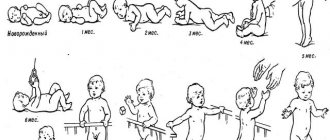Crawling is one of the most important stages in the development of a child in the first year of life. We'll tell you why this skill is useful and how to encourage your baby to make his first independent movements.
The first meaningful smile, the first erupted tooth, the first hesitant step - all these precious moments are so important for young parents. Without exaggeration, the development of a baby in the first year of life is progressing by leaps and bounds. Moms and dads record countless videos, take hundreds of photographs and notes in beautiful notebooks to keep in their memory every stage of their beloved baby’s growing up. Children grow incredibly fast. Just yesterday you were carrying a squeaking bundle out of the maternity hospital, and today the inquisitive fidget is exploring every corner of the apartment, moving quickly on all fours.
Often, parents are in a hurry and are terribly proud if the child “skips” some important milestones of growing up and, for example, begins to walk earlier than his peers. Meanwhile, not a single change in our body happens just like that. Each process is determined by physiological necessity and contributes to harmonious and versatile development.
Crawling is no exception to this rule. Pediatricians strongly do not recommend trying to speed up the natural course of events and encouraging the baby to take an upright position as early as possible by placing him in a walker, jumper, or in any other way. By the way, in some European countries and Canada, these devices have long been prohibited from production and sale.
When answering the question at what months do children begin to crawl, it is necessary to take into account the gender factor. Of course, every little person is individual, but, as a rule, girls are more active and inquisitive and begin to show interest in crawling a little earlier - at 5-7 months. Boys master a new method of movement a little later - around 6-8 months. Let us repeat that all these indicators are averaged, and you should not panic if the deadlines shift by a month or two.
More well-fed infants are usually somewhat lazier than their slender peers, and new active movements are given to them with great difficulty.
It is also important to note that the above standards are designed for full-term babies born after the 38th week of pregnancy. In the case of premature babies, all indicators shift slightly upward.
Why is crawling useful?
Pediatricians vying with each other about the fact that crawling is absolutely necessary. Let's figure out what the value of this skill is.
- Crawling helps develop coordination and a sense of self in space.
- By moving independently, and not in the arms of parents, the child learns to navigate within the premises.
- Visual perception and sensory skills develop.
- Fine motor skills of the hands are improved, which is very important for the development of speech in the future. Speech therapists and neurologists noticed that children who crawled a lot were less likely to have problems pronouncing sounds.
- Muscle tone goes away, especially if during this important period of life the baby is given a course of special massage.
- Crawling is a complete physical activity for a baby. The muscles of the arms, legs and back are strengthened no worse than in adults during aerobics or in the gym.
- My horizons are expanding. Having mastered a useful skill, a child has the opportunity to move independently and explore such an interesting world around him. It is for this reason that it is not recommended to limit his freedom with the help of a playpen and closed doors. Security can be ensured in other ways.
- While moving on all fours, alternate work of both hemispheres of the brain is ensured.
- The first prerequisites for the development of logical thinking are laid, since now the baby has new opportunities to get what he wants.
- Due to intensive training of all muscle groups and a soft, gradual load on the spine, smooth preparation occurs for the transition of the body to an upright position and walking.
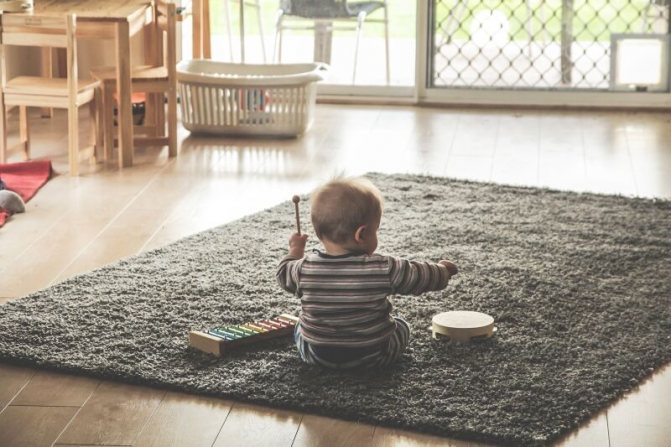
Exercises for classes
To understand when a child should get on all fours, you need to make sure that he can support his weight well on outstretched arms, first on two, then on one. The following exercises will help you do this.
The baby is placed on his tummy and a bright toy is held above his head. As the child tries to grab it, the adult raises the toy higher, pushing the baby to raise his torso and hold it with one hand.
To help your baby understand how to learn to stand on all fours, you can help him in the following way. The baby is placed on a bolster-shaped pillow or folded blanket so that the arms and legs hang freely. The baby will want to regain his balance and will rest his limbs on the floor, thereby getting on all fours.
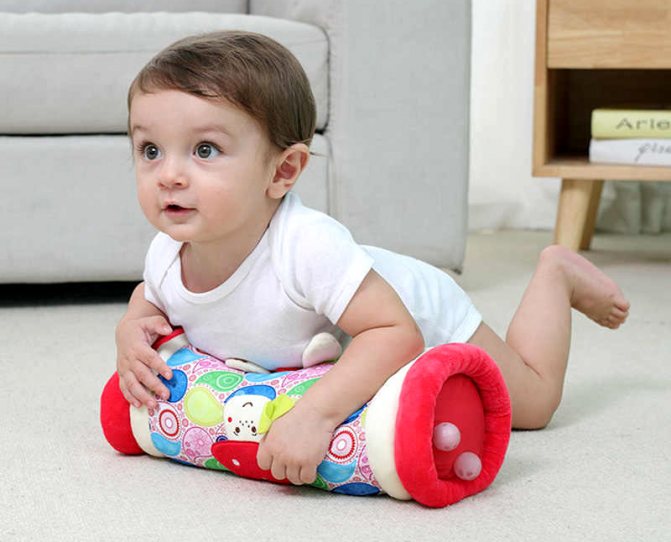
Baby on a roller
The following simple technique will help your child learn to stand on his knees. Sitting on the floor, the mother presses the baby with her back to her in an upright position. With the other hand, bends your knees so that they touch the floor. Then he gradually lowers the baby so that he rests his hands on the floor and stands on all fours. If the baby straightens his legs and lies on his tummy, you need to start all over again.
The last exercise will help the child learn to move his legs like crawling. To do this, you need to take a high, dense pillow or other object that you can lean on. The baby is placed so that the upper part of the body is on a pillow, and he rests on his knees on the floor. Then the adult smoothly pulls the pillow forward by the opposite edge. Thus, the baby is forced to rearrange his legs and crawl.
How babies crawl
There are two ways to crawl. Often one precedes the second, but definitely each of them is useful in its own way and is a necessary stage of development, helping to strengthen the musculoskeletal system.
- Plastun style. Requires significant labor from the baby. Moving forward is achieved by pushing with your feet and pulling with your hands.
- On knees. Teaches you to maintain balance and coordinate the movements of the lower and upper half of the body. It causes great delight because it allows you to quickly and, most importantly, without outside help, overcome distances that are significant by a child’s standards and achieve what you want.
The main thing is readiness
You can teach a child to crawl no earlier than his body is ready for it. It is important to remember this and not harm it with excessive loads.
What does it mean - ready? This means that the child can:
- confidently hold your head in any position;
- keep your back straight in a sitting position;
- roll over on your tummy and back;
- make crawling movements while lying on your tummy.
In other words, the baby should have sufficiently strengthened all the muscles necessary for crawling. This happens at different times for different children. Some begin to crawl at 5 months, others at 7 or 8 months. Therefore, if parents want their little one to quickly begin to explore the surrounding space, it is important to help him strengthen the necessary muscles in a timely manner. To do this, starting from 4 months, you can do a special set of exercises:
- strengthening massage;
- spreading the arms to the sides and then crossing them on the chest;
- turning on your tummy, lying in this position;
- flexion-extension of the arms;
- "bike";
- lifting the body (with support from the handles) in a prone position;
- alternate and joint flexion-extension of the legs;
- pushing off the mother's chest with the legs in a supine position;
- pushing off the legs from the support (arms), lying on the stomach;
- learning the skill of grasping objects (from the front, from above, from the sides) from a position on the stomach.
Remember that at first the baby will crawl on its belly, and only then will it learn to get up on all fours (or you will teach it). Therefore, when the baby’s muscles get stronger, stimulate him to “crawl on his stomach” by moving a bright toy (preferably a sound one) in front of him. Help if necessary by placing your palm under his heels for support. And be sure to praise him if he makes progress. Then the child’s desire to crawl will be much stronger.

How a baby begins to crawl: main stages
Forming and consolidating any skill takes some time, so you shouldn’t force things. Let your baby get a good feel for himself and his body in the new state before moving on to the next stage. Nothing happens for nothing, and each subsequent fragment complements the previous one, forming a puzzle and turning a baby helplessly moving its arms and legs into a tiny person standing confidently on two legs. There are several particularly important transition points:
- The baby begins to hold his head in a prone position. This significant event occurs in the second or third month of life. Experts recommend placing the baby on the tummy more often to strengthen the back, shoulders and neck.
- Support on the hands appears. The same laying on the stomach stimulates the child to see what is happening outside his changing table, and for this he has to rise first with support on his elbows, and a little later on his palms.
- Even the most awkward-looking babies should not be left unattended on the sofa or other surfaces raised above the floor. Children learn very quickly, and before you can blink your eye, the fidget will master the skill of turning over first from the stomach to the back, and then vice versa. At this moment, the child realizes that he can get to his favorite toy on his own.
- The young researcher manages to lean not only on his hands, but also on his knees. It would seem that it’s time to hit the road, but the fragile body still doesn’t give in and refuses to follow orders, so for the time being you have to be content with rhythmically swaying back and forth.
- Finally, the efforts are rewarded, and the baby begins to move, first on his belly, and then on all fours.
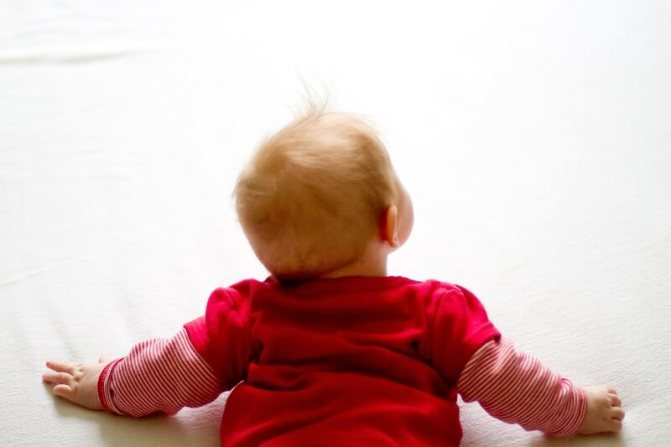
Doctors' opinion
Experts disagree on the question of how many months a child should learn to crawl. For many modern doctors this is not so important. The neurologist checks muscle tone, checks reflexes... And if everything is normal and the child does not crawl, you will be sent home without any diagnoses. However, some experts say that babies should normally be crawling and sitting at 6 months.
Jean Ledloff’s book “How to Raise a Happy Child” says that “children who don’t crawl” miss opportunities for development. In the first year of life, physical movement stimulates brain development. And attempts to crawl also mean the development of coordination, exploration of space, new discoveries... Therefore, it is very desirable that your baby sooner or later masters locomotion (it is considered the most useful for toddlers of this age). Sometimes mothers find it convenient that the baby is almost motionless. Where they left it, it sits there. He doesn’t turn over chests of drawers, doesn’t go into dangerous places... But for the harmonious development of a child, this situation is not very good.
What does the ability to crawl depend on?
Sometimes children begin to crawl later due to hypertonicity (or vice versa, hypotonicity). Sometimes a child, for some reason, is simply physically weak. Sometimes the baby is not very active by nature. He is interested in sitting and studying toys for hours, rather than conquering space. In many cases, even if a toddler at 8 months does not want to crawl, this is normal. Therefore, the task of parents is simply to regularly visit a neurologist. And don’t worry about trifles.
My daughter has been very active and mobile since birth. From 3-4 months she made her first serious attempts to crawl. By six months she was already moving around the room well. At 9 months she learned to walk. And my son... He crawled only when he was 7.5 months old, and then quite lazily. And now, at almost 9 months, although he can crawl, he prefers to sit in one place.
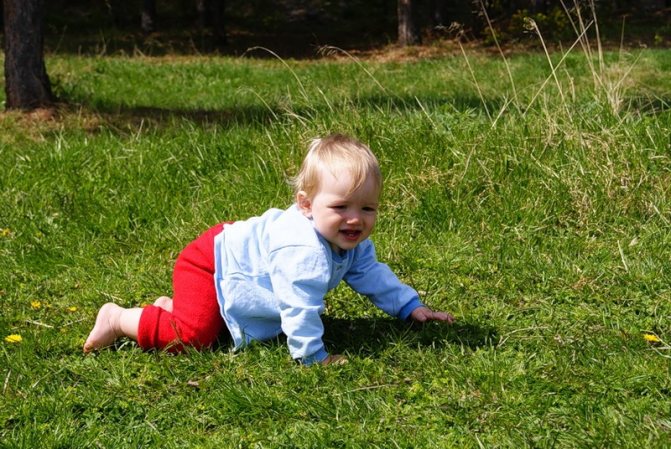
How to help your child start crawling?
How to teach a baby to move? And is this possible? It is impossible to teach. But a little help is quite possible.
- Most importantly, place your baby on the floor as often as possible. If your little one is constantly in your arms, in a crib or playpen, he will not learn anything. Teach your baby to play on the floor. Place toys a little further away so that the child tries to reach them. The baby crawls when he needs to.
- Experts believe that massage and gymnastics help children. Usually the clinic shows the principles of massage for your age. Don't neglect it. This is not only useful, but also pleasant and strengthens the bond between you and your child.
- If the little one can already get on all fours, you can show him how best to move his arms and legs to move around. To be honest, it didn't help us. My son stood on all fours for a month, swayed and did not crawl. No matter how they “explained” it to him. And my daughter crawled quite quickly and without outside help.
- To help children learn to move on their stomachs, you need to place your palms on their feet while lying on their stomachs. This can be done even from birth. By resting their feet on your hands, babies learn the basic principles of crawling.
- Take off your baby's pants. It is much easier to learn to crawl with bare knees. Yes, at first the skin will turn a little red. But it’s not scary, she should become coarser. The main thing is that the floor surface is free of splinters.
If you are concerned about the development of babies from the cradle, then you will be interested in these programs.
I hope the article answered your questions. Subscribe to blog updates and share the link to the article on social networks. See you in touch! I wish you a wonderful motherhood!
Why hasn't the baby crawled yet?
The reasons why a child does not want to start crawling can be very different, and for some the household members themselves are to blame:
- Parents and grandparents do not provide enough freedom. Agree, it’s difficult to move if all your movements are limited by the confines of a playpen, stroller, crib, or even the hands of adults.
- By giving the child what he wants at the first squeak, we do him a disservice by depriving him of the motivation to crawl. It is much easier to shout demandingly than to try to get to the goal on your own.
- Character traits. The point may be that in your family, not an active traveler was born, but a calm contemplator.
- Wrinkles on the body and chubby cheeks are very cute, but the weight can make it difficult to move.
- If something alarms you in the behavior of your son or daughter, the baby seems too lethargic or weak - this is a reason to immediately consult a doctor. If the orthopedist and neurologist confirm that health is in perfect order and their patient is simply lazy, they can proceed to active action.
If the child does not crawl
We looked at how to teach a baby to crawl. But what if he has not mastered this process? Every baby develops at his own pace, so don't panic if he hasn't started crawling yet. This process takes a long time to learn, so be patient. The child may not be ready for this. Keep in mind that premature babies are characterized by later development. Read about the development of premature babies and a baby at one month at the link.
You should start worrying after nine months. If your baby is not yet crawling on all fours at 10-11 months, contact your pediatrician! The doctor will find out why the baby is not crawling yet and will prescribe appropriate exercises and massage so that the baby can quickly master this process.
Do not be surprised or alarmed if the child crawls backwards or sideways, or moves on his back. There is nothing wrong with this, the baby has found the most convenient and comfortable way of transportation. The main thing is that he moves, and crawling does not have to be traditional. In this case, show the correct version of crawling using your own example or the example of another child.
For accelerated development and learning, you can use a special crawling track.
This is a narrow changing table with a soft middle and sides. You can buy a ready-made track or build the equipment yourself from a board or table and a soft blanket. The table is slightly tilted and first the baby is taught to crawl from top to bottom, and then transferred to crawling up, while the legs are supported by the palm. Subscribe to our VKontakte group
How to help your baby start crawling
Before you start teaching your baby to crawl, you need to think through everything down to the smallest detail and adapt the surrounding space to his needs, completely eliminating any dangers. The ideal place for training is the floor, and not the parent's bed. The surface must be flat and without elevations. Make sure that there are no small parts on it that are so interesting to put in your mouth or nose. Hide all the wires, put plugs on the sockets, and secure the drawers and cabinet doors with special fasteners, which are easy to find in any children's store or hypermarket. Don't rely on chance! Carelessness is unacceptable here!
After you have put everything in order and washed the floor, you can proceed directly to training:
- Create an incentive to move. Take a favorite toy or other safe object of interest to the child and place it a little away. It is important not to overdo it, so as not to discourage you from achieving your goal. The goal should be achievable, and the distance to the goal should be increased gradually.
- Praise the diligent student for every inch he obeys. The reaction of adults is of great importance. A smile and sincere praise are the best motivation. Don’t expect quick results if you sit indifferently on the couch, staring at your phone. The task of parents is not only to ensure safety, but also to captivate.
- Crawl with the whole family! Kids learn from the personal example of mom and dad. If you have older children, include them too. Fun guaranteed!
- If you have friends with children the same age or a little older who are already crawling confidently, invite them to visit more often. Other people's successes are very motivating.
- At such an early age, babies do not yet know how to share toys and will make every effort to crawl away from their “competitor.”
Each child is individual. Some develop “as if by a textbook” in full accordance with accepted standards, while others lag behind or, conversely, are in a hurry to move to a new stage, skipping the previous one. Watch your baby, notice his features and encourage him to explore this wonderful world. Everything will definitely work out!
Teach a child to crawl
There is a direct connection between the age at which children crawl and how much time parents spend on developmental exercises for babies. With the right actions you can help your baby learn to move faster. To do this, you need to lay your child on his stomach as often as possible and motivate him to move forward by placing interesting colorful objects nearby. If sanitary and temperature conditions allow, it is better to place the baby on the floor. Physical exercise affects not only the time at which children begin to crawl, but also the development of their brain activity.
